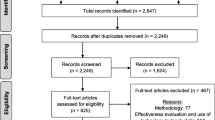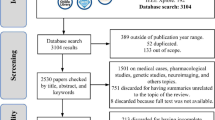Abstract
This study aimed to review digital interventions in the treatment of autism spectrum disorder (ASD). A systematic review and meta-analysis was conducted. Nineteen studies were included. The interventions aimed to improve social skills (n = 11), developmental skills (n = 2) and 6 other different targets. Technology used were computer programs (n = 14), tablet apps (n = 3), a robot (n = 1) and an interactive DVD (n = 1). The meta-analysis resulted in an overall effect size (Cohen’s d) of 0.32 [0.12–0.51], indicating a small effect. Heterogeneity between studies was high (I2 = 100%), limiting the generalization of results. Therefore, we recommend larger RCT studies, and guidelines for the development of trials evaluating digital interventions for ASD, for making comparison of future studies possible.
Registration can be found online at Prospero: https://www.crd.york.ac.uk/prospero/, registration no. CRD42020146542.





Similar content being viewed by others
References
American Psychiatric Association. (2000). Diagnostic and statistical manual of mental disorders (4th ed., text rev.).
American Psychiatric Association. (2013). Diagnostic and statistical manual of mental disorders (5th ed.).
Cohen, J. (1977). Statistical power analysis for the behavioral sciences. New York: Academic Press.
Conaughton, R. J., Donovan, C. L., & March, S. (2017). Efficacy of an internet-based CBT program for children with comorbid High Functioning Autism Spectrum Disorder and anxiety: A randomised controlled trial. Journal of Affective Disorders, 218, 260–268. https://doi.org/10.1016/j.jad.2017.04.032
De Vries, M., Prins, P. J. M., Schmand, B. A., & Geurts, H. M. (2014). Working memory and cognitive flexibility-training for children with an autism spectrum disorder: A randomized controlled trial. J Child Psychol Psychiatry. https://doi.org/10.1111/jcpp.12324
Faja, S., Aylward, E., Bernier, R., & Dawson, G. (2008). Becoming a face expert: A computerized face-training program for high-functioning individuals with autism spectrum disorders. Developmental Neuropsychology, 33(1), 1–24. https://doi.org/10.1080/87565640701729573
Faja, S., Webb, S. J., Jones, E., Merkle, K., Kamara, D., Bavaro, J., et al. (2012). The effects of face expertise training on the behavioral performance and brain activity of adults with high functioning autism spectrum disorders. Journal of Autism and Developmental Disorders, 42(2), 278–293. https://doi.org/10.1007/s10803-011-1243-8
Fletcher-Watson, S., Petrou, A., Scott-Barrett, J., Dicks, P., Graham, C., O’Hare, A., et al. (2016). A trial of an iPadTM intervention targeting social communication skills in children with autism. Autism, 20(7), 771–782. https://doi.org/10.1177/1362361315605624
Fridenson-Hayo, S., Berggren, S., Lassalle, A., Tal, S., Pigat, D., Meir-Goren, N., et al. (2017). ‘Emotiplay’: A serious game for learning about emotions in children with autism: Results of a cross-cultural evaluation. European Child & Adolescent Psychiatry, 26(8), 979–992. https://doi.org/10.1007/s00787-017-0968-0
Golan, O., Ashwin, E., Granader, Y., McClintock, S., Day, K., Leggett, V., & Baron-Cohen, S. (2010). Enhancing emotion recognition in children with autism spectrum conditions: An intervention using animated vehicles with real emotional faces. Journal of Autism and Developmental Disorders, 40(3), 269–279. https://doi.org/10.1007/s10803-009-0862-9
Golan, O., & Baron-Cohen, S. (2006). Systemizing empathy: Teaching adults with Asperger syndrome or high-functioning autism to recognize complex emotions using interactive multimedia. Development and Psychopathology, 18(2), 591–617. https://doi.org/10.1017/S0954579406060305
Grynszpan, O., Weiss, P. L., Perez-Diaz, F., & Gal, E. (2014). Innovative technology-based interventions for autism spectrum disorders: A meta-analysis. Autism, 18(4), 346–361. https://doi.org/10.1177/1362361313476767
Hatfield, M., Falkmer, M., Falkmer, T., & Ciccarelli, M. (2017). Effectiveness of the BOOST-ATM online transition planning program for adolescents on the autism spectrum: A quasi-randomized controlled trial. Child and Adolescent Psychiatry and Mental Health, 11(1), 1–12. https://doi.org/10.1186/s13034-017-0191-2
Higgins, J. P. T., Thompson, S. G., Deeks, J. J., & Altman, D. G. (2003). Measuring inconsistency in meta-analyses. British Medical Journal, 327(7414), 557–560. https://doi.org/10.1136/bmj.327.7414.557
Hollis, C., Falconer, C. J., Martin, J. L., Whittington, C., Stockton, S., Glazebrook, C., & Davies, E. B. (2017). Annual Research Review: Digital health interventions for children and young people with mental health problems: A systematic and meta-review. Journal of Child Psychology and Psychiatry, 58(4), 474–503. https://doi.org/10.1111/jcpp.12663
Hopkins, I. M., Gower, M. W., Perez, T. A., Smith, D. S., Amthor, F. R., Casey Wimsatt, F., & Biasini, F. J. (2011). Avatar assistant: Improving social skills in students with an ASD through a computer-based intervention. Journal of Autism and Developmental Disorders, 41(11), 1543–1555. https://doi.org/10.1007/s10803-011-1179-z
Humm, L. B., Olsen, D., Be, M., Fleming, M., & Smith, M. (2014). Simulated job interview improves skills for adults with serious mental illnesses. In Annual Review of Cybertherapy and Telemedicine 2014: Positive Change: Connecting the Virtual and the Real (Vol. 99, pp. 50–54). IOS Press. https://doi.org/https://doi.org/10.3233/978-1-61499-401-5-50
Jouen, A. L., Narzisi, A., Xavier, J., Tilmont, E., Bodeau, N., Bono, V., et al. (2017). GOLIAH (Gaming open library for intervention in autism at home): A 6-month single blind matched controlled exploratory study. Child and Adolescent Psychiatry and Mental Health, 11(1), 1–14. https://doi.org/10.1186/s13034-017-0154-7
Kaufman, A. S., & Kaufman, N. L. (1990). Kaufman brief intelligence test. Circle Pines, MN: American Guidance Service.
Kumazaki, H., Muramatsu, T., Yoshikawa, Y., Corbett, B. A., Matsumoto, Y., Higashida, H., et al. (2019). Job interview training targeting nonverbal communication using an android robot for individuals with autism spectrum disorder. Autism. https://doi.org/10.1177/1362361319827134
Kumazaki, H., Warren, Z., Corbett, B. A., Yoshikawa, Y., Matsumoto, Y., Higashida, H., et al. (2017). Android robot-mediated mock job interview sessions for young adults with autism spectrum disorder: A pilot study. Frontiers in Psychiatry, 8, 1–8. https://doi.org/10.3389/fpsyt.2017.00169
Lai, M.-C., Lombardo, M. V., & Baron-Cohen, S. (2014). Autism. The Lancet, 383(9920), 896–910. https://doi.org/10.1016/S0140-6736(13)61539-1
Lopata, C., Thomeer, M. L., Rodgers, J. D., Donnelly, J. P., & McDonald, C. A. (2016). RCT of mind reading as a component of a psychosocial treatment for high-functioning children with ASD. Research in Autism Spectrum Disorders, 21, 25–36. https://doi.org/10.1016/j.rasd.2015.09.003
Milne, M., Raghavendra, P., Leibbrandt, R., & Powers, D. M. W. (2018). Personalisation and automation in a virtual conversation skills tutor for children with autism. Journal on Multimodal User Interfaces, 12(3), 257–269. https://doi.org/10.1007/s12193-018-0272-4
Mitchell, P., Parsons, S., & Leonard, A. (2007). Using virtual environments for teaching social understanding to 6 adolescents with autistic spectrum disorders. Journal of Autism and Developmental Disorders, 37(3), 589–600. https://doi.org/10.1007/s10803-006-0189-8
Moher, D., Liberati, A., Tetzlaff, J., & Altman, D. G. (2009). Preferred reporting items for systematic reviews and meta-analyses: The PRISMA statement. PLoS Medicine, 6(7), e1000097. https://doi.org/10.1371/journal.pmed.1000097
Odom, S. L., Thompson, J. L., Hedges, S., Boyd, B. A., Dykstra, J. R., Duda, M. A., et al. (2015). Technology-aided interventions and instruction for adolescents with autism spectrum disorder. Journal of Autism and Developmental Disorders, 45(12), 3805–3819. https://doi.org/10.1007/s10803-014-2320-6
Parsons, D., Cordier, R., Lee, H., Falkmer, T., & Vaz, S. (2019). A randomised controlled trial of an information communication technology delivered intervention for children with autism spectrum disorder living in regional Australia. Journal of Autism and Developmental Disorders, 49(2), 569–581. https://doi.org/10.1007/s10803-018-3734-3
Peters-Scheffer, N., Didden, R., Korzilius, H., & Matson, J. (2012). Cost comparison of early intensive behavioral intervention and treatment as usual for children with autism spectrum disorder in the Netherlands. Research in Developmental Disabilities. https://doi.org/10.1016/j.ridd.2012.04.006
Ramdoss, S., Lang, R., Mulloy, A., Franco, J., O’Reilly, M., Didden, R., & Lancioni, G. (2011). Use of computer-based interventions to teach communication skills to children with autism spectrum disorders: a systematic review. Journal of Behavioral Education, 20(1), 55–76. https://doi.org/10.1007/s10864-010-9112-7
Ramdoss, S., Machalicek, W., Rispoli, M., Mulloy, A., Lang, R., & O’Reilly, M. (2012). Computer-based interventions to improve social and emotional skills in individuals with autism spectrum disorders: A systematic review. Developmental Neurorehabilitation, 15(2), 119–135. https://doi.org/10.3109/17518423.2011.651655
Rogge, N., & Janssen, J. (2019). The economic costs of autism spectrum disorder: A literature review. Journal of Autism and Developmental Disorders., 49, 2873–2900. https://doi.org/10.1007/s10803-019-04014-z
Root, J. R., Stevenson, B. S., Davis, L. L., Geddes-Hall, J., & Test, D. W. (2017). Establishing computer-assisted instruction to teach academics to students with autism as an evidence-based practice. Journal of Autism and Developmental Disorders, 47(2), 275–284. https://doi.org/10.1007/s10803-016-2947-6
Sandbank, M., Bottema-Beutel, K., Crowley, S., Cassidy, M., Dunham, K., Feldman, J. I., et al. (2020). Project AIM: Autism intervention meta-analysis for studies of young children. Psychological Bulletin, 146(1), 1–29. https://doi.org/10.1037/bul0000215
Silver, M., & Oakes, P. (2001). Evaluation of a new computer intervention to teach people with autism or Asperger syndrome to recognize and predict emotions in others. Autism, 5(3), 299–316. https://doi.org/10.1177/1362361301005003007
Spaniol, M. M., Shalev, L., Kossyvaki, L., & Mevorach, C. (2018). Attention training in autism as a potential approach to improving academic performance: A school-based pilot study. Journal of Autism and Developmental Disorders, 48(2), 592–610. https://doi.org/10.1007/s10803-017-3371-2
Sterne, J., Savović, J., Page, M., Elbers, R., Blencowe, N., Boutron, I., et al. (2019). RoB 2: A revised tool for assessing risk of bias in randomised trials. BMJ, 366, I4898.
Strickland, D. C., Coles, C. D., & Southern, L. B. (2013). JobTIPS: A transition to employment program for individuals with autism spectrum disorders. Journal of Autism and Developmental Disorders, 43(10), 2472–2483. https://doi.org/10.1007/s10803-013-1800-4
Tanaka, J. W., Wolf, J. M., Klaiman, C., Koenig, K., Cockburn, J., Herlihy, L., et al. (2010). Using computerized games to teach face recognition skills to children with autism spectrum disorder: The Let’s Face It! program. Journal of Child Psychology and Psychiatry and Allied Disciplines, 51(8), 944–952. https://doi.org/10.1111/j.1469-7610.2010.02258.x
Voss, C., Schwartz, J., Daniels, J., Kline, A., Haber, N., Washington, P., et al. (2019). Effect of wearable digital intervention for improving socialization in children with autism spectrum disorder. JAMA Pediatrics, 173(5), 446. https://doi.org/10.1001/jamapediatrics.2019.0285
Whitehouse, A. J. O., Granich, J., Alvares, G., Busacca, M., Cooper, M. N., Dass, A., et al. (2017). A randomised controlled trial of an iPad-based application to complement early behavioural intervention in Autism Spectrum Disorder. Journal of Child Psychology and Psychiatry and Allied Disciplines, 58(9), 1042–1052. https://doi.org/10.1111/jcpp.12752
WHO. (1992). The ICD-10 classification of mental and behavioural disorders: Clinical descriptions and diagnostic guidelines.
Zakzanis, K. K. (2001). Statistics to tell the truth, the whole truth, and nothing but the truth: formulae, illustrative numerical examples, and heuristic interpretation of effect size analyses for neuropsychological researchers. Archives of Clinical Neuropsychology, 16(7), 653–667.
Acknowledgements
We would like to thank Maria Tækker, Povl Munk-Jørgensen, Pia Veldt Larsen, Céline Croucher Vasarhelyi, Psychiatric Research Academy, Ole Jacob Storebø and Thomas Bernhard for their help and support.
Funding
This research received no specific grant from any funding agency in the public, commercial, or not-for-profit sectors.
Author information
Authors and Affiliations
Contributions
This study was designed and prepared by HS and NB. The search and selection of studies was conducted by HS and LHF. The dataextraction, Risk of Bias assessment and analysis was conducted by HS. The manuscript was written by all authors.
Corresponding author
Ethics declarations
Conflict of interest
The authors declare that they have no conflict of interest.
Additional information
Publisher's Note
Springer Nature remains neutral with regard to jurisdictional claims in published maps and institutional affiliations.
Rights and permissions
About this article
Cite this article
Sandgreen, H., Frederiksen, L.H. & Bilenberg, N. Digital Interventions for Autism Spectrum Disorder: A Meta-analysis. J Autism Dev Disord 51, 3138–3152 (2021). https://doi.org/10.1007/s10803-020-04778-9
Accepted:
Published:
Issue Date:
DOI: https://doi.org/10.1007/s10803-020-04778-9




